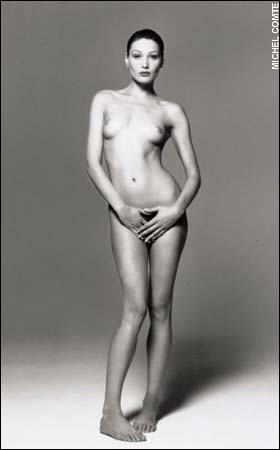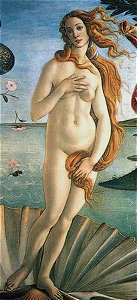 |
|
Naked or Nude?
The eye of the beholder
By Lennie Bennett, S.P. Times Art Critic
Published Friday, April 18, 2008
Is Carla Bruni naked or nude? • This photograph of her unclothed body has been
widely circulated through the media and the Internet since it was sold to an anonymous
collector at a Christie's auction on April 10 for what was considered the wildly inflated
sum of $91,000, after Christie's estimated its worth between $3,000 and $4,000.
Naked versus nude may seem like a small, irrelevant distinction in a debate over the
propriety of the photograph's sale. But those two words represent important and very
different ways not only in how we look at an image but how we judge its value and the
value of those involved in its creation. And a recent shift has occurred in how we might
perceive and judge the photograph of Carla Bruni.
It was taken in 1993 by Michel Comte, a respected commercial photographer, when Bruni
was a top model. Many months ago, it was a minor player in the sale of 135 photographs
owned by the distinguished German collector Gert Elfering, not in the same league as, say,
those by Richard Avedon or Irving Penn, both of whom were also represented and whose
photographs were valued in the $100,000 range. Christie's assessment of the Bruni-Comte
photograph seemed spot-on because Comte is still living, he isn't in the highest ranks of
photographers and the Bruni photo isn't from a special or limited-edition. And several
months ago Bruni, 40, was just an ex-model with a fairly successful singing career and a
string of famous lovers (e.g. Mick Jagger). Then in February she married Nicholas Sarkozy,
president of France. |
You can guess what happened next.
After the Bruni-Sarkozy wedding, Christie's suddenly elevated the image to the small group
of special photographs used to promote the auction. Bidding at the event went through the
roof with the anonymous collector finally snagging the print for $91,000. And Madame
Sarkozy's birthday suit was posted far more frequently on Web sites than the little gray
suits from Dior she wore on a state visit to Britain that same week.
She and her husband reportedly feel victimized and exploited by the sale. Knee-jerk
reaction would concur.
But let's look at her response through the prism of art history. The naked/nude question
is a subcategory of — and inevitably leads to — the Big Question: What Is Art?
Bruni's photograph has made it a more potent question not based on the photograph's merits
or even who she was in 1993. Its value now seems based on who she has become, a personage
rather than a person, someone with the potential to exert influence, even power, on an
international, political level.
Here's what the late Lord Kenneth Clark, one of the most respected art historians of the
20th century and maybe of all time, said about naked versus nude in his classic book from
the 1950s, The Nude: A Study in Ideal Form:
"To be naked is to be deprived of our clothes, and the word implies some
of the embarrassment most of us feel in that condition. The word 'nude,' on the other
hand, carries, in educated usage, no uncomfortable overtone. The vague image it projects
into the mind is not of a huddled, defenseless body, but of a balanced, prosperous, and
confident body."
The bottom line for Clark was that nude is art and naked is not: "… in the
greatest age of painting (the Renaissance), the nude inspired the greatest works."
 |
|
Nude confers power; naked implies helplessness. In an ironic coda for Bruni, the
elevation that has given her access to a power base has also been the agent of its
potential loss.
If we believe she is naked, we agree with her that she has been victimized and exploited;
if she is nude, we view her as the fortunate subject of a work of art whose physical form
is celebrated and glorified. And, it's important to remember, that in 1993 she was at the
top of her game and had collaborated often with Comte for fashion magazines such as Vogue.
She was no desperate naif persuaded to remove her clothes by a cheesy adventurer. The
Medicis, an Italian renaissance family who had their own broad power base, were
unequivocal about the woman Botticelli painted for them in The Birth of Venus (c.
1482-1486) which you see here in a pose similar to Bruni's. It's believed to be a homage
to Simonetta Cattaneo Vespucci, the greatest beauty of her day who was loved by Giuliano
de Medici. Like Bruni, she wears no clothes. Unlike Bruni, Simonetta — and her rich
and famous boyfriend — would have considered the portrait and public interest in it
honorable things.
"Look at my woman!" it proclaims. "Isn't she gorgeous!"
President Sarkozy has made, at the time of this writing, no comment about his wife's
portrait. |
Lord Clark, in discussing naked and nude, did not take very seriously the
ascension of photography as an art form in the latter part of the 20th century and the
role it would play in the genre of nude portraiture. As we all know, a photograph today
can be manipulated every bit as much as a painting. But it has the illusion of
unadulterated reality which affects our sensibilities about it, especially in this
instance, with an immediacy and intimate directness. A photograph can convey a feeling of
voyeurism far more often than a painting or sculpture. That and its potential to be
endlessly reproduced often distinguish it in people's minds from paintings and sculpture.
Nor did Clark reckon with the pervasive influence of popular contemporary culture. I can't
think of any women who look more "balanced, prosperous or confident" than
Playboy centerfolds and the gals who happily pull up their shirts on their Web sites. And
the highly paid models who remove their clothes for respected photographers.
And while I would disagree with those who claim a Hustler photograph as art, I would argue
their right to have different definitions of art from mine, just as I would defend others
at the opposite end of the spectrum in their right to believe that no representation of
the unclothed body is art, that Botticelli's unclothed Venus is as naked as Venus the
Stripper on MySpace.
More common is the middle ground of those who would be enchanted by Botticelli and
appalled by Helmut Newton's provocative, subtly sado-masochistic photographs that have
been published in every high-end magazine in the world.
As a point of reference, Newton's Tied-Up Torso, a photograph of a bare-chested woman in
semi-bondage get-up, went for $109,000 at the auction.
I am, of course, using a few words out of context from Clark's lengthy discussion of a
classic art genre to make a point about how personal our ideas are about the question,
what is art?
This auction was not about prurience or aberrant tastes. It contained some true
photographic masterworks, some of them nudes, along with landscapes, portraits and still
lifes.
Examples from the auction and what they sold for:
• Irving Penn's portrait of a nude Gisele Bundchen, $193,000
• Avedon's Bridget Bardot (face only), $181,000
• Horst's unidentified model wearing a Mainbocher corset, $133,000
• Penn's portrait of Picasso (fully clothed), $133,000
• Richard Avedon's semi-nude of Lauren Hutton, $127,000
• Penn's nude of Kate Moss, $97,000
• Herb Ritt's nude of Alex Wek (probably the most revealing nude in the group),
$25,000
• Albert Watson's nude of Kate Moss, $21,250
• David Bailey's portrait of John Lennon and Paul McCartney (fully clothed), $16,250
• Neil Armstrong and Buzz Aldrin's documentary photograph of the moon's surface from
their Apollo craft, $6,250
• Garry Fabian Miller's seascape, $6,250
• Michel Comte's portrait of Jeff Koons (fully clothed) $3,250
• Comte's nude of Carla Bruni, $91,000.
I expect you're seeing a pattern. Except for the last example, which is the anomaly.
It's an undistinguished photograph of a pretty girl in an awkward, postmodern pose, taken
after a shoot for Italian Vogue according to Comte, the kind of outtake common with models
and photographers who are comfortable with each other. It looks quickly and casually made
with none of the care taken to pose and compose an image that you see in many other
photographs from the auction. And, according to a description by Christie's, it is
unsigned and has no reference to the number of prints Comte has made of the image, unlike
almost all other high-priced photographs in the auction which are part of very small,
beautifully made limited editions. It was in the lowest category of Christie's estimates
for those reasons.
When my editors and I talked about this story, I argued hard for inclusion of the complete
photograph of Carla Bruni. They decided against it (the naked/nude thing again).
Now I believe they were right.
I can only hope Anonymous Collector bought it for the best reason in the world, because he
loved it.
I'm skeptical.
I can imagine a scenario in which the French president and first lady go on some state
visit and encounter Anonymous Collector who will say to her, "Oh, Carla, how nice to
see you in clothes!"
I can also image a scenario in 10, 20 or 30 years, when Carla Bruni is no longer a
personage and Anonymous Collector will realize that this was not investment art.
If the photograph had sold for $4,000, Carla Bruni would be nude.
At $91,000, Carla Bruni is naked.
Lennie Bennett can be reached at (727) 893-8293
back to Education
ringlingdocents.org
|

